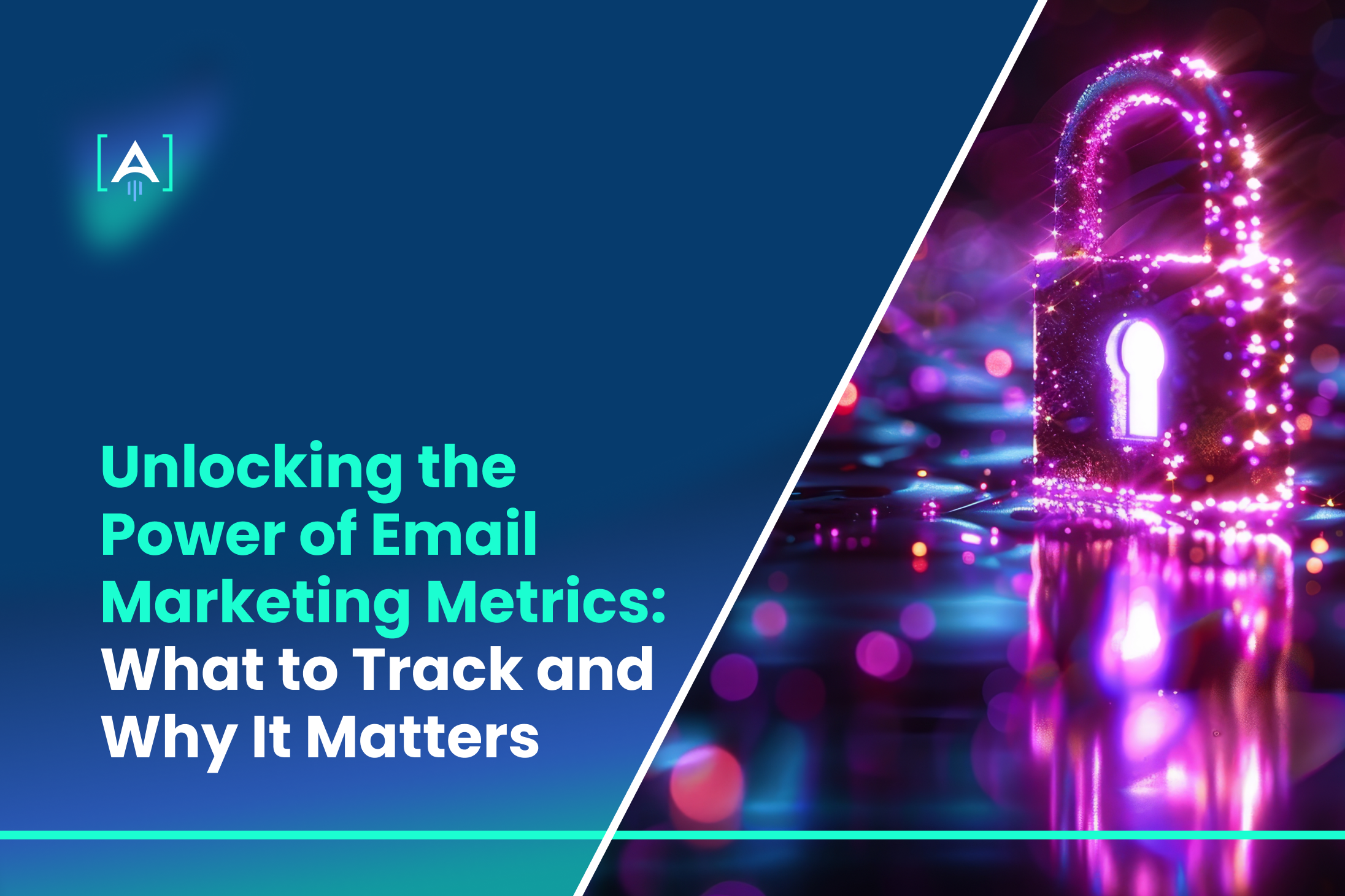Have you ever wondered how to measure the success of your email marketing campaigns?
It’s not just about sending out emails. It’s about understanding how your audience interacts with them. That’s where email marketing metrics come into play.
Despite the growth and prominence of mobile messengers and chat apps, e-mail is an integral part of daily online life.
In 2023, the number of global e-mail users amounted to 4.37 billion.
Source: Forbes
Statista highlights that the growth is set to grow to 4.89 billion users in 2027.
Key Values for Email Marketing:
- High ROI Potential
- Personalized Communication
- Measurable Results
As a consequence, partnering with an experienced Email Marketing Agency will become even more crucial for businesses looking to tap into this massive and expanding audience and craft tailored strategies.
The blog post will explore the world of email metrics, stating the key indicators like open rates, click-through rates, conversion rates, and more.
1. Maximizing Engagement with Data-Driven Insights: Tracking Open Rates
When it comes to email marketing, success isn’t just about sending emails—it’s about knowing whether people actually open them.
Open rates, a key email marketing metric, are essential indicators of engagement and interest, offering business owners and CEOs a clear window into how well they are at creating email campaigns that resonate with their audience.
But how do you track them effectively, and more importantly, how do they impact your business?
What Are Open Rates, and Why Should CEOs Care?
Open rates measure the percentage of recipients who actually open your email. It may sound simple, but this number reveals so much more. It’s not just about eyeballs; it’s about engagement—a crucial aspect in the modern business world where personalized customer journeys and AI-driven marketing strategies dominate.
When you look at metrics for email marketing, open rates are often the first thing you check.
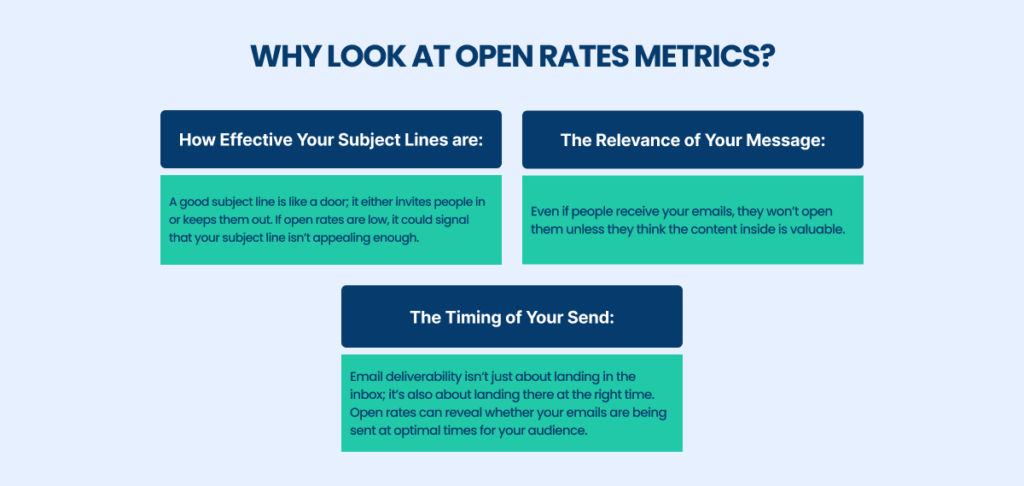
CEOs should care about open rates because they represent one of the most tangible metrics for email marketing that reflect audience interest.
And in the era of AI email marketing, optimizing open rates can be the first step toward more automated, targeted communication with your customer base.
What Can Affect Your Open Rates?
Understanding the variables that impact open rates is crucial for making adjustments that will actually move the needle.
Source: HubSpot
The Key factors to keep an eye on are:
- Subject Lines
Your subject line is the first impression. It needs to be short, punchy, and relevant. Avoid spammy words like “free” or “urgent,” which can lower email deliverability and get your message marked as spam.
- Personalization
Personalized email campaigns tend to perform better. Something as simple as including the recipient’s name in the subject line can increase the likelihood of an email being opened. According to the research, personalized emails can boost open rates by as much as 26%.
- Send Times
Timing matters. An email sent at 2 AM is unlikely to get much traction. Using email analytics tools can help determine when your audience is most active, ensuring your message doesn’t get buried under others.
- Email Deliverability
If your email doesn’t land in the recipient’s inbox, it doesn’t matter how great your subject line is. Make sure your email list is clean and that your emails follow best practices to avoid spam filters.
- Reputation and Trust
People open emails from sources they trust. Building a reputable brand that consistently delivers value is key to improving open rates over time.
2. Driving Conversions: Why Click-Through Rate (CTR) Is Key to Success
CTR isn’t just a number—it’s a reflection of how well your email customer journey is working.
A high CTR means that your audience is engaged, interested, and ready to take the next step with your business, whether that’s exploring more content, making a purchase, or booking a consultation.
For CEOs, CTR is one of the most straightforward indicators of campaign success for the following reasons:
- Measures Engagement: CTR is a direct gauge of how engaged your audience is with your content. It shows whether your email is compelling enough for the recipient to want more.
- Indicates Content Relevance: If your CTR is high, it suggests your message is relevant to your audience’s needs and interests.
- Leads to Conversions: A high CTR is the first step toward conversions—whether that’s a sale, a sign-up, or another action important to your business goals.
The bottom line: a high CTR indicates that you’re delivering valuable content to your audience, keeping them engaged, and driving them further along the email customer journey.
Source: Data Box
How to Boost CTR: Simple but Effective Strategies
If your metrics for email marketing show a low CTR, don’t worry—there are plenty of ways to optimize your campaigns. A few tactics that can have a big impact on your CTR:
1. Create Irresistible CTA Buttons
Your Call to Action (CTA) is the most critical element of your email. It’s the gateway between your email and your website, product page, or landing page. To boost your CTR, ensure that your CTA buttons are:
- Clear and Action-Oriented: Use direct, action-driven language like “Shop Now,” “Learn More,” or “Get Started.”
- Eye-Catching: Make your CTA button stand out visually with bold colors that contrast against the email background.
- Accessible: Ensure that your CTA is placed in a prominent position so readers don’t have to search for it.
That’s a statistic worth keeping in mind when designing your next campaign.
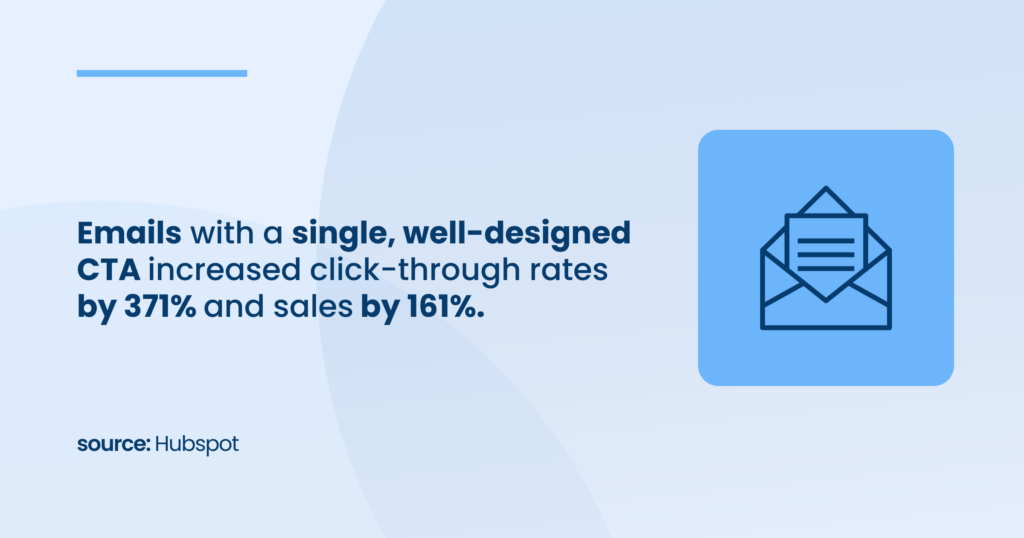
2. Improve Content Relevance
People are more likely to click on something that speaks directly to their interests or solves their problems. This is where email segmentation and personalized email marketing come in handy.
- Segment Your Audience: Group your email list into specific segments based on behaviors, demographics, or purchase history. Send tailored content that’s relevant to each segment.
- Personalize the Message: Include the recipient’s name and customize the email’s content based on their past interactions with your brand. Personalization increases both open rates and CTR. In fact, personalized emails deliver six times higher transaction rates, according to Experian.
3. Optimize for Mobile Devices
Did you know that 61.9% of email opens happen on mobile devices?
If your emails aren’t optimized for mobile, you could be missing out on a large portion of your audience. Ensure that your email design, CTA buttons, and content are mobile-friendly for maximum reach and engagement.
- Use Responsive Design: Your emails should automatically adjust to fit any screen size, ensuring a seamless experience for mobile users.
- Keep It Concise: Long paragraphs can be overwhelming on a small screen. Break up your content into smaller, digestible sections.
3. Conversion Rates: The Moment of Truth – Are They Buying?
Why is conversion rate such a game-changer for CEOs? Because it shows the direct impact of your emails on your bottom line.
Source: Invespcro
Conversion rate is one of the most valuable email marketing metrics for any business owner or CEO.
It represents the percentage of email recipients who completed a desired action after opening your email, such as making a purchase, signing up for a service, downloading a resource, or filling out a form. In essence, conversion rates measure how well your emails are driving real business outcomes.
For business leaders, this metric is crucial because it goes beyond just tracking opens or clicks. It quantifies how effective your email marketing strategies are at generating tangible results.
Whether you’re running ecommerce email marketing campaigns or engaging in B2B email marketing, tracking conversion rates provides you with a clear understanding of your ROI.
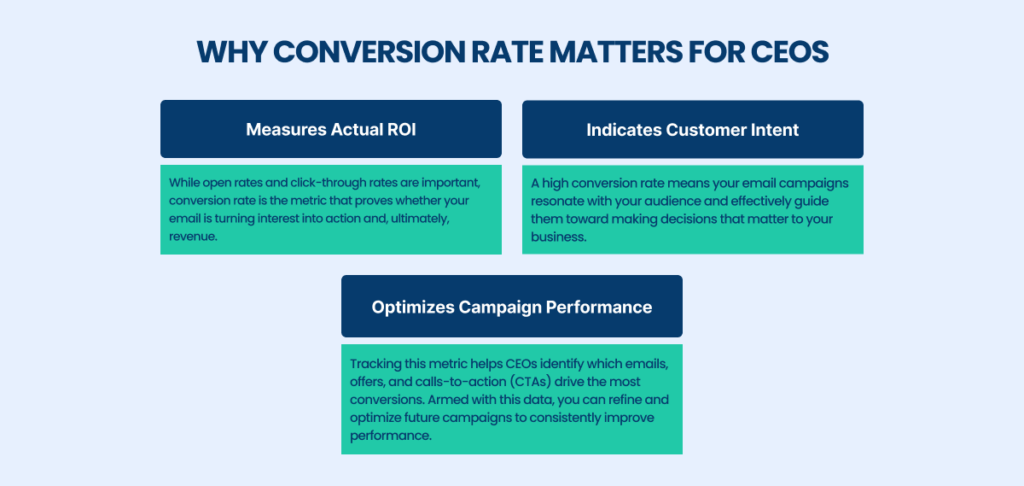
From Inbox to Checkout: Turning Opens into Dollars
Now that we understand the importance of conversion rates let’s discuss how you can increase them. Driving conversions from an email takes more than just sending a compelling message.
You need a well-rounded approach that makes it easy for recipients to move from curiosity to commitment.
1. Streamlined Checkout Process
One of the biggest reasons potential customers abandon a purchase is a complicated or time-consuming checkout process. For business owners, ensuring a streamlined checkout experience is crucial for boosting conversions. When recipients click through from your email, the buying process should be quick, intuitive, and friction-free.
- Reduce the Steps: The fewer clicks and forms your customer has to fill out, the better. Offering a guest checkout option or integrating one-click purchase solutions can significantly reduce cart abandonment.
- Mobile Optimization: With the majority of users opening emails on mobile devices, it’s essential that your checkout process is optimized for mobile. A study by Statista highlights that mobile accounts for 54.8% of global website traffic, making mobile-friendly emails and checkout processes key to conversion success.
2. Use Discount Codes and Limited-Time Offers
Nothing motivates people to take action like a discount. Offering exclusive discount codes or limited-time offers within your email can create urgency and drive more conversions.
For CEOs, this strategy can be particularly effective when paired with personalized content.
- Exclusive Offers: Send out personalized email campaigns to specific segments of your audience, offering them an exclusive discount code. Personalization can boost open rates, and when tied to a meaningful offer, it can also lead to higher conversion rates.
- Create Urgency: Include phrases like “24-hour sale” or “Limited stock available” to instill a sense of urgency. This psychological nudge encourages recipients to take action before they miss out.
3. Effective Landing Pages: Close the Deal
Once a recipient clicks through your email, they should land on a page designed to convert. A poorly designed or confusing landing page can halt your recipient’s progress, preventing a sale or sign-up. For CEOs, ensuring that your landing pages are optimized for conversions is crucial.
- Align with Your Email Message: The content and offers on your landing page should match what was promised in the email. Consistency builds trust and prevents confusion. For example, if your email promotes a 15% discount, ensure that the landing page highlights this offer prominently.
- Compelling CTAs: Just like in your emails, your landing page should feature clear and compelling CTAs. Buttons like “Claim My Discount” or “Start My Free Trial” encourage action and guide visitors toward completing the conversion.
- Social Proof and Trust Signals: Adding customer testimonials, reviews, or even security badges (like SSL certifications) can reassure potential buyers that they’re making a safe and informed choice.
4. Bounce Rates: Is Your Message Even Getting Through?
Bounce rates are one of the most critical factors for ensuring your emails reach their intended audience.
A bounce occurs when an email is not delivered to a recipient’s inbox, and this can significantly impact the success of your email marketing KPIs.
For business owners and CEOs, understanding bounce rates is essential to maintaining strong email deliverability, engagement, and, ultimately, a better email marketing ROI.
But not all bounces are created equal.
There are two types: hard bounces and soft bounces. Let’s break these down:
- Hard Bounces: These are permanent failures, meaning the email address is invalid, no longer exists, or is blocked. Once an email hard bounces, it will never be successfully delivered.
Continuing to send emails to these addresses can damage your sender reputation, which is crucial for keeping your emails out of spam folders. For instance, if you repeatedly send to hard-bounced addresses, email service providers (ESPs) like Gmail or Outlook might see your emails as spammy, lowering your overall deliverability.
- Soft Bounces: These are temporary issues, such as a full inbox or a server that is down. The email might still be delivered later, or it may bounce again if the issue isn’t resolved. While soft bounces are not as concerning as hard bounces, they still require monitoring because if they persist, it could indicate larger issues.
Why CEOs Should Care About Bounce Rates
For business owners and CEOs, ensuring that emails actually reach the inbox is crucial. High bounce rates can cripple your email marketing strategies, leading to wasted resources and diminishing your email marketing ROI.
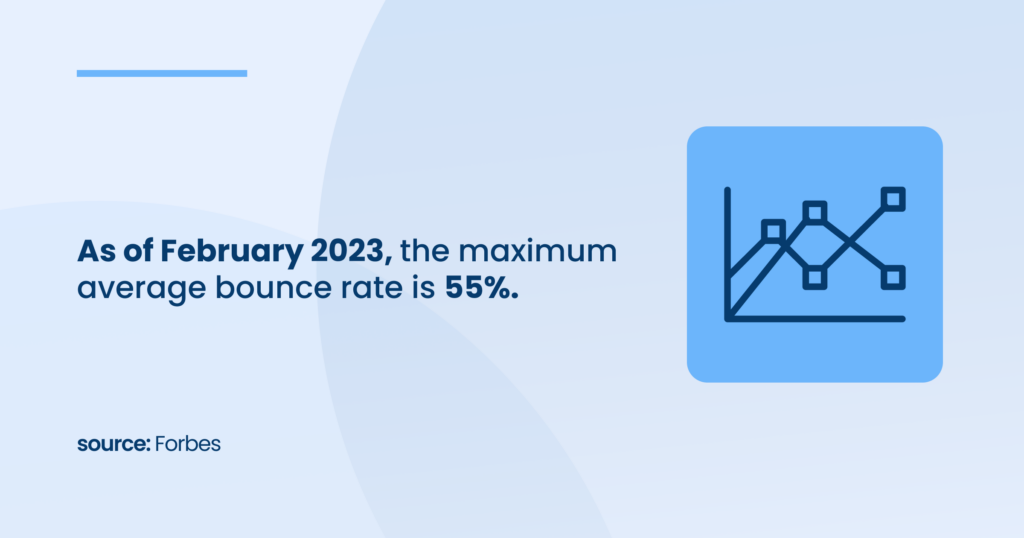
High bounce rates can hurt your sender reputation, meaning fewer of your emails will make it to the inboxes of decision-makers.
Bounce-Proof Your Emails: Keeping Your Message in the Inbox
The good news is that while bounces are inevitable, there are practical ways to minimize them.
1. Regularly Clean Your Email List
One of the simplest yet most effective strategies to reduce bounce rates is to regularly clean your email list.
Over time, email lists naturally degrade—people change jobs, abandon email addresses, or enter invalid emails.
- Remove Hard Bounces: As soon as you identify email addresses that consistently hard bounce, remove them from your list. Continuing to email hard bounces will harm your sender reputation.
- Manage Soft Bounces: Monitor soft bounces. If an address has soft-bounced multiple times, consider removing it from your list. Sometimes, the recipient’s inbox is full, or the server is temporarily down, but persistent soft bounces should be flagged.
- Use AI Email Marketing Tools: Leveraging AI email marketing solutions can help automate the process of list cleaning, identifying inactive or problematic addresses and saving you time.
2. Segment Your Audience for Better Targeting
Segmentation is not just a strategy for boosting engagement; it can also help reduce bounce rates.
By segmenting your email list, you can send highly relevant emails to specific groups, minimizing the chance that your emails end up in spam or are ignored.
- Create Segments Based on Engagement: One smart way to segment is by engagement. Separate active, highly engaged users from those who haven’t opened your emails in months. You can create re-engagement campaigns for the less active segments but don’t send the same emails to everyone.
- Target CEOs and Decision-Makers: If your business is targeting decision-makers, such as CEOs, consider a special segment for these high-priority contacts. Tailoring your content and message specifically to their needs can increase the chances of successful delivery and engagement.
3. Improve Email Authentication and Sender Reputation
Another way to reduce bounce rates is by ensuring that your emails are properly authenticated. Implementing email authentication protocols like SPF, DKIM, and DMARC helps verify that your emails are coming from a legitimate source. This reduces the chances of your emails being flagged as spam or getting bounced.
- Check Your Sender Reputation: Regularly monitor your sender reputation using tools like Sender Score or Postmaster Tools. A poor reputation can drastically lower your email deliverability and increase bounces.
- Warm Up New IPs: If you’re sending emails from a new IP address, it’s important to gradually build up your sending volume—known as “warming up” the IP—so that email providers don’t flag your domain as suspicious.
5. Unsubscribe Rates: Is Your Audience Losing Interest?
When running an email marketing campaign, few metrics for email marketing are as gut-wrenching as the unsubscribe rate. Seeing someone opt out of your carefully crafted content can feel like rejection, but for business owners and CEOs, understanding why people are unsubscribing can offer valuable insights.
Unsubscribe rates are an important part of your email marketing metrics. A sudden spike in opt-outs can signal deeper issues like over-emailing or a mismatch between what your audience expects and what you’re delivering.
Source: Mailchimp
While some level of unsubscribes is normal, keeping a close eye on this metric is essential to ensuring your campaigns stay effective.
Before They Say Goodbye: How to Keep Your Audience Hooked
So, how do you reduce unsubscribe rates and keep your audience hooked on your emails? The key lies in offering value, maintaining relevance, and ensuring you strike the right balance with your email frequency.
1. Personalization: Speak Directly to Your Audience
One-size-fits-all emails are a fast track to unsubscribes. People don’t want to feel like just another email on a mass list—they want to know that the content you send is tailored to them. Personalized email marketing can make a huge difference in how your audience engages with your campaigns.
Consider this:
- Segmenting your email list based on interests, behaviors, and past interactions ensures that you send the right message to the right audience.
- Use your subscribers’ names, recommend products based on past purchases, or offer custom solutions based on their business challenges.
According to a study by Campaign Monitor, emails with personalized subject lines are 26% more likely to be opened, and personalization can increase CTR by as much as 14%.
2. Dynamic Content: Keep It Fresh and Engaging
Static emails that look the same each time won’t keep people interested for long. Instead, use dynamic content that adapts to your audience’s behaviors and preferences. This makes your emails feel more like a conversation and less like a broadcast.
- Dynamic product recommendations: If you’re in eCommerce email marketing, showing customers products based on their browsing history or previous purchases can drastically increase engagement.
- Time-sensitive offers: Sending personalized offers or discounts with dynamic countdown timers can create a sense of urgency and excitement, making people more likely to engage and less likely to opt-out.
Engagement is crucial. When people find your content valuable and exciting, they’re far more likely to stick around.
3. Value-Driven Emails: Always Give a Reason to Stay
People unsubscribe when they don’t see value. To reduce unsubscribe rates, make sure every email has a purpose and offers something of value, whether it’s educational content, actionable tips, or exclusive deals.
- Offer exclusive insights: Business owners and CEOs are busy. They want to open an email and immediately see something useful. Include actionable tips, industry insights, or key trends that are relevant to their business growth.
- Educational Content: Instead of just sending promotions, offer valuable content that helps solve problems. For instance, in cold email marketing, sending an insightful whitepaper or offering access to a webinar can keep people engaged without overwhelming them with sales pitches.
According to HubSpot, 47% of recipients decide to open an email based on the subject line alone, and ensuring the email content delivers on that promise is key to retention.
The Bottom Line: Turning Unsubscribes into Retention
As a CEO or business owner, analyzing your email marketing metrics and specifically focusing on unsubscribe rates can save your business from losing valuable prospects. By creating personalized, dynamic, and value-driven emails, you’ll not only keep your audience engaged but also reduce those dreaded opt-outs.
Focus on tailoring your content to each segment of your audience, balancing frequency, and always offering something of value.
When your email feels more like a helpful resource and less like an intrusion, you’ll be well on your way to improving your overall email marketing ROI and retaining more loyal subscribers.
Reminder: Thoughts on the Power of Email Marketing Metrics
Understanding and tracking email marketing metrics is essential for any CEO or business owner aiming to optimize their campaigns and improve their ROI.
What You should remember:
- Open Rates: These are your first measure of success. High open rates indicate effective subject lines and good email deliverability, offering a clear view of audience engagement.
- Click-Through Rates (CTR): CTR reflects how well your content resonates with your audience. By crafting compelling CTAs and relevant content, you can drive more engagement and conversions.
- Conversion Rates: The ultimate measure of success in email marketing. High conversion rates show that your emails are not only reaching your audience but also driving meaningful actions like purchases or sign-ups.
- Bounce Rates: Keeping bounce rates low is crucial for maintaining email deliverability. Regularly clean your email lists and improve targeting through segmentation to ensure your emails reach decision-makers.
- Unsubscribe Rates: Unsubscribe rates offer insight into how well your content aligns with your audience’s expectations. By focusing on personalization and delivering value with every email, you can keep your audience engaged and reduce opt-outs.
Excelling in email marketing is not just about sending emails but also about making sure each one serves a strategic purpose—driving engagement, conversions, and, ultimately, business growth.
Email Marketing Metrics as a Growth Driver
Email marketing metrics aren’t just numbers. They’re powerful tools that can lead your business growth.
Indeed, [A] Growth Agency can interpret the metrics and provide the roadmap to refine your strategies, enhance personalization, and drive meaningful interactions. We’re a Growth agency where data-driven strategies meet creative experiments.
Excellence is our standard. We believe in the power of data to inform and drive every strategy, ensuring our actions are as effective as they are innovative.
When you work with us, you’re not just getting a marketing agency—you’re gaining a partner committed to elevating your business through innovative, data-powered solutions.
So what to do?
